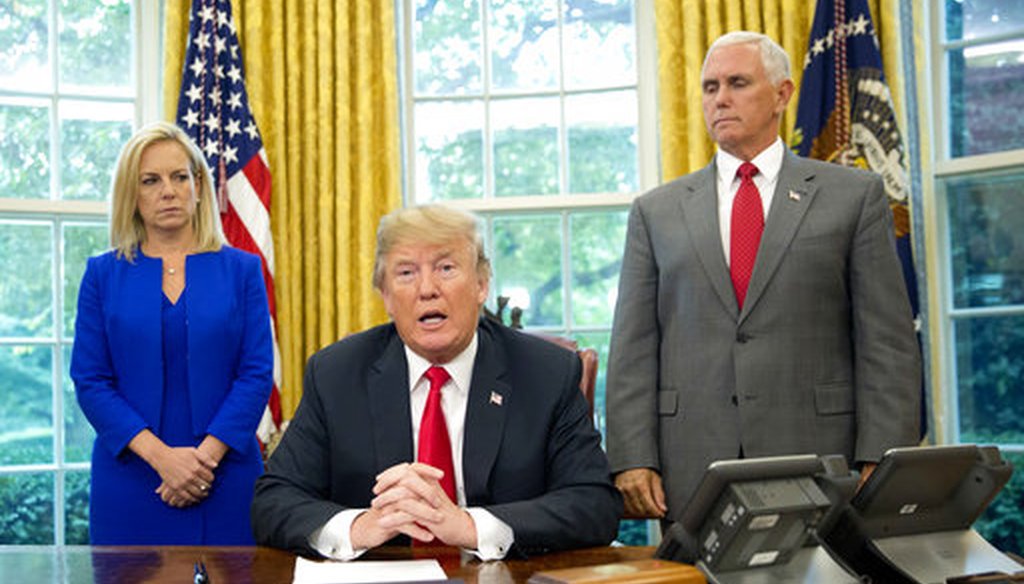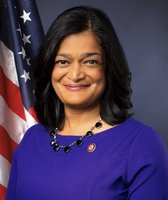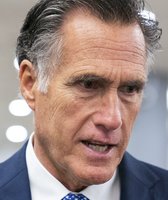Stand up for the facts!
Our only agenda is to publish the truth so you can be an informed participant in democracy.
We need your help.
I would like to contribute

President Donald Trump with Homeland Security Secretary Kirstjen Nielsen and Vice President Mike Pence, signs an executive order to end family separations. (AP Photo/Pablo Martinez Monsivais)
After falsely claiming that immigrant families were being separated at the border because of Democrats and arguing that he was unable to do anything about it, President Donald Trump signed an executive order to keep children and parents together in detention.
The June 20 executive order came after growing criticism of Trump’s "zero-tolerance" policy, which calls for the prosecution of all immigrants who come to the United States illegally.
Prior to the executive order, the zero-tolerance policy caused the separation of parents and children traveling together. Parents were referred for prosecution and taken into federal custody; children were sent to the U.S. Health and Human Services Department, which placed them with sponsors (such as family members), in shelters, or foster homes.
At least 2,342 children were separated from their parents between May 5 and June 9 as a result of the Trump’s policy. Even though Trump has signed an order to stop the separations, questions remain about its implementation and the fate of the children who have already been separated.
Here’s an overview of what’s known and what’s uncertain.
No. The executive order does not say the prosecution policy is over. It emphasized that the administration will "rigorously enforce" immigration laws and "initiate proceedings" accordingly.
"So we're keeping families together, and this will solve that problem," Trump said June 20. "At the same, we are keeping a very powerful border, and it continues to be a zero tolerance. We have zero tolerance for people that enter our country illegally."
U.S. Customs and Border Protection Commissioner Kevin K. McAleenan said on June 25 that his agency had temporarily stopped referring for prosecution adults traveling with children, the New York Times reported.
But on the same day, Attorney General Jeff Sessions, advocated for enforcement of the law.
Refusing to prosecute adults for illegal entry "would be a disservice to the people of this country," Sessions said according to prepared remarks for the National Association of School Resource Officers. "The President has made clear: we are going to continue to prosecute those adults who enter here illegally. But we are going to do everything in our power to avoid separating families," Sessions said.
Asked about McAleenan's statement, White House press secretary Sarah Sanders on June 25 said, "this is a temporary solution."
"This isn't going to last. Congress still has to step up. They still have to do their job. This will only last a short amount of time because we're going to run out of space, we're going to run out of resources in order to keep people together, and we're asking Congress to provide those resources and do their job. ...
We're not changing the policy. We're simply out of resources, and, at some point, Congress has to do what they were elected to do, and that is secure our border," Sanders said.
What’s different now is that families are expected to be kept together, even if a parent faces prosecution for breaking immigration laws.
Families will be detained together "where appropriate and consistent with law" and based on available resources, the order said. (Past administrations released many immigrants awaiting court hearings partly because they didn’t have enough detention space.)
Trump’s order directed the Defense Secretary to provide to DHS any existing facilities available for the housing and care of immigrant families, and to "construct such facilities if necessary and consistent with law."
Heads of executive departments and agencies were also ordered to assist with the housing and care of immigrant families with pending court proceedings for improper entry.
Children will be separated from their parents if the U.S. government has concerns that keeping them together "would pose a risk to the child’s welfare."
No. An executive order was not necessary to stop family separations. There is no law calling for the separation of families. The separations have been a consequence of the Trump administration’s "zero-tolerance" policy.
Trump’s executive order does not address how children will be reunited with their families.
But at least 538 children have been reunited with the adults they were separated from, according to a June 24 tweet from DHS Spokesman Tyler Q. Houlton.
A June 23 DHS factsheet said that as of June 20, there were 2,053 separated minors in HHS-funded facilities, and that efforts were underway to reunite families. The factsheet also said that a parent who is ordered removed from the United States may request that his or her minor child accompany them.
But immigrant rights advocates and lawyers contend that the Trump administration does not have a clear plan for the reunification of families, and that parents are unable to find out where the government sent their children.
As PolitiFact Wisconsin noted, on the day of Trump’s order, an HHS spokesperson said there would be no special effort from the Trump administration to reunite separated families. Later the same day, the department said the spokesperson had misspoken.
Yes, to an extent. This is where the 1997 Flores settlement agreement comes in.
The Flores agreement established nationwide standards for the detention, release, and treatment of unaccompanied minors in custody of the U.S. government. It stemmed from lawsuits against the government alleging mistreatment of detained unaccompanied minors during the 1980s.
The agreement outlined to whom an unaccompanied children can be released as they await a resolution of their immigration case. If a release is not possible, then the government is required to hold a child in the "least restrictive setting appropriate to the minor's age and special needs."
The California-based 9th U.S. Circuit Court of Appeals in 2016 held that the Flores agreement applied to all minors, not just those traveling unaccompanied. Federal courts have also interpreted the agreement as limiting children detention to no more than 20 days.
Given these restrictions, the Obama administration released parents alongside their children.
Trump directed the Attorney General to file a request with the U.S. District Court for the Central District of California to modify the Flores settlement and allow immigration officials "under present resource constraints, to detain alien families together throughout the pendency of criminal proceedings for improper entry or any removal or other immigration proceedings."
Courts must now address this issue in light of Trump's order.
"The Flores settlement will need to be revised to allow indefinite detention of children," Kevin Johnson, immigration law professor and dean of the UC Davis School of Law, previously told PolitiFact. "That seems unlikely. The court refused to allow the Obama administration to detain children for long periods in response to the influx of Central Americans in 2014."
Our Sources
Listed in the story.




































